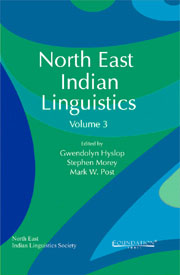2 - The Evolution and Recent Development of the Meitei Mayek Script
from The View from Manipur
Published online by Cambridge University Press: 26 October 2011
Summary
Manipur is a small state in North East India. Many different communities inhabit the state. The total population of the state is approximately 2,400,000 (Directorate of Census Operations, Manipur 2001). There are thirty-three different tribal communities which are recognized by the state government. They are Aimol, Anal, Angami, Chiru, Chothe, Gangte, Hmar, Kabui, Kacha Naga, Kharam, Koirao, Koireng, Kom, Lamkang, Mao, Maram, Maring, Monsang, Moyon, Paite, Paomai, Purum, Ralte, Sema, Simte, Sahte, Tangkhul, Tarao, Thadou, Vaiphei, Zou, any Kuki and any Mizo (Lushai). They speak different languages, all of which belong to the Tibeto-Burman family. Among them nine different languages are recognized as Modern Indian Languages. They are Thadou, Paite, Tangkhul, Hmar, Rongmei (Kabui), Mao, Zhou, Kom and Vaiphei. There are also Meitei Muslims, called Pangals, in the state.
In addition to these groups are the Meiteis, who comprise the largest community in terms of population. The people of Manipur are collectively known as Manipuri, and this term is also used for the state official language of Manipur, which is one of the Modern Indian Languages. This language, which is in fact the first language of the Meitei people, is also called Meiteirol/Meiteilon. Manipuri/Meiteilon is the lingua franca of the state. The language has been regarded as one of the most important regional languages of the nation and has been listed in the Eighth Schedule of the constitution of India. People speaking the language also live in the neighbouring states of Assam and Tripura and in some parts of Bangladesh and Burma, now Myanmar.
- Type
- Chapter
- Information
- North East Indian Linguistics , pp. 24 - 32Publisher: Foundation BooksPrint publication year: 2011
- 5
- Cited by



